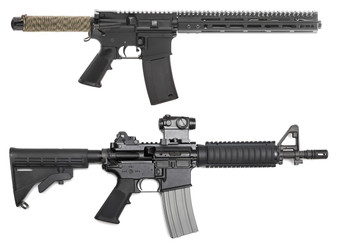AR15 Rifle vs AR Pistol: What's The Difference?
Posted by GunBuilders.com on Mar 15th 2024
The AR platform, originally developed by Eugene Stoner, has become one of the most popular firearm platforms, prized for its modularity, reliability, and easy customization. Besides its dozens of available calibers, the AR comes in two flavors: Rifle and pistol. While they may look alike at a glance, there are significant differences between the two, ranging from barrel length to legal considerations. Let's take a look at those differences.
Barrel Length

The primary distinction between an AR15 rifle and an AR pistol lies in their barrel length. An AR15 rifle must have a barrel 16" or longer -- this is the minimum legal length of any barrel on any rifle ( unless you register your AR as a short-barreled rifle). On the other hand, an AR pistol sports a shorter barrel, with some calibers and configurations -- like 9mm AR9 -- using a barrel as short as 5". This difference in barrel length has several implications.
AR15 Rifle
- Longer barrel promotes better accuracy over longer distances.
- Increased muzzle velocity due to longer barrel length, resulting in better terminal ballistics.
- Often equipped with a traditional rifle stock, enhancing stability for precision shooting.
- Suitable for various applications including hunting, target shooting, and home defense.
AR15 Pistol
- Shorter barrel offers enhanced maneuverability, making it ideal for close-quarters engagements.
- Reduced muzzle velocity compared to rifles due to shorter barrel, affecting long-range accuracy.
- Equipped with a pistol brace rather than a traditional stock, providing support while maintaining legality.
- Excellent for personal defense, tactical applications, and as a compact firearm for transportation.
Legality of AR Pistols
The legality of AR pistols is a crucial consideration for firearm enthusiasts. Federal laws define a pistol as a firearm designed to be fired with one hand, typically with a barrel length of less than 16 inches. As such, AR pistols must adhere to specific criteria to avoid classification as a short-barreled rifle (SBR), which is subject to stringent regulations under the National Firearms Act (NFA).
To maintain compliance with federal regulations, AR pistols are equipped with a pistol stabilizing brace rather than a traditional stock. These braces are designed to be strapped to the shooter's forearm, effectively converting the firearm into a pistol configuration. However, it's essential to stay informed about evolving laws and regulations, as interpretations and enforcement practices may vary by jurisdiction.
Buttstocks vs Pistol Braces

The choice between a traditional buttstock and a pistol stabilizing brace is a defining factor in distinguishing between an AR15 rifle and an AR pistol.
Buttstock (AR Rifle)
- Provides enhanced stability and support for precision shooting.
- Designed to be shouldered, facilitating consistent aiming and recoil control.
- Typically adjustable for length of pull to accommodate different shooters.
- Subject to federal regulations governing rifle configurations, including minimum barrel length requirements.
Pistol Brace (AR Pistol)
- Designed to strap to the forearm, allowing the shooter to stabilize the firearm.
- Intended to be used in conjunction with one-handed shooting techniques.
- Offers versatility in shooting positions and can aid in controlling recoil.
- Helps maintain compliance with federal regulations regarding the classification of firearms.
Pros and Cons of an AR15 Rifle
Pros
- Longer Range Accuracy: Longer barrel length promotes improved accuracy over extended distances.
- Versatility: Well-suited for various applications including hunting, target shooting, and home defense.
- Stability: Equipped with a traditional stock for enhanced stability and control during shooting.
- Effective Terminal Ballistics: Higher muzzle velocity results in better terminal ballistics, ideal for hunting and self-defense scenarios.
Cons
- Less Maneuverable: Longer barrel and stock configuration hinder maneuverability in tight spaces.
- Regulatory Considerations: Subject to federal regulations governing rifle configurations, including barrel length requirements.
- Bulkier: Larger size and weight may be less conducive to certain applications, such as concealed carry or tactical operations.
Pros and Cons of an AR15 Pistol
Pros
- Enhanced Maneuverability: Shorter barrel and compact design make it ideal for close-quarters engagements and tactical use.
- Compact Size: Easily portable and suitable for use in confined spaces, such as vehicles or home defense scenarios.
- Versatile Shooting Positions: Pistol brace allows for versatile shooting positions and aids in recoil control.
- Compliance: Designed to meet federal regulations for pistols, minimizing legal complexities associated with short-barreled rifles.
Cons
- Reduced Long-Range Accuracy: Shorter barrel length results in decreased muzzle velocity and accuracy over longer distances.
- Limited Stock Options: Pistol braces may offer less customization compared to traditional rifle stocks.
- Single-Handed Operation: Although designed for one-handed shooting, may be less stable than rifles when firing.
No matter which AR configuration you're building, we've got you covered: Check out our available AR rifle kits and AR pistol kits. We have dozens of configurations available, with different barrel lengths, calibers, and accessories -- including pistol braces for pistol configurations, and match-grade stainless barrels for some rifle configurations.
DISCLAIMER: If you are new to the world of DIY gun building, you likely have a lot of questions and rightfully so. It’s an area that has a lot of questions that, without the correct answers, could have some serious implications. At GunBuilders.com, we are by no means providing this content on our website to serve as legal advice or legal counsel. We encourage each and every builder to perform their own research around their respective State laws as well as educating themselves on the Federal laws. When performing your own research, please be sure that you are getting your information from a reliable source.

